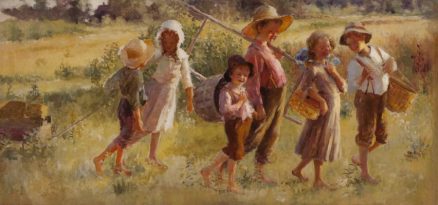- Categories
- Children
- Landscapes
- Zoom in on Artwork
- Print Page
- Email Page to Friend
Cherries Are Ripe is typical of Adam Emory Albright’s idyllic paintings of rural youth. Armed with empty baskets and a ladder, six smiling children dally across an open field, evidently in pursuit of a pleasurable outing as much as a bountiful crop. Varied by age, gender, and height, they are barefoot and dressed in practical bonnets, straw hats, and somewhat ragtag outfits. Emphasizing the autonomy of a rural child’s world, the composition is scaled to the youthful figures; they dominate the scene, with the high horizon creating a sheltering refuge of the surrounding fields and distant fence, trees, and house. Low sunlight illuminates the figures, highlighting their happy faces; two glance directly toward the viewer as if in invitation to join them. Gestures and expressions link the children together, with the eldest boy holding the youngest’s hand protectively while another two join in pulling a wagon that bears an additional empty basket in anticipation of a rich harvest. The painting’s airy, casual brushwork, reflecting Albright’s on-site working method, underscores his theme of joyful contentment. The artist often hand-carved his own frames; in this example, he embellished the corners with luxuriant images of slender cherry leaves and clusters of fruit.
Albright probably painted Cherries Are Ripe in the summer of 1903, soon after the Art Institute of Chicago presented two successful solo exhibitions of his works. Later that year, the painting also appeared in the Art Institute’s annual exhibition of American art, where its generous size and striking frame may have been calculated to maintain the artist’s public visibility amidst a host of nationally prominent artists. Cherries Are Ripe was reproduced in the Chicago Evening Post and hailed by critic Lena McCauley as a “transcript of merry childhood from his collection of paintings illustrating the life of the American country child.”i The following year, the painting was shown in the Society of Western Artists’ eighth annual exhibition, and it was reproduced in a review of the show published in the journal Brush and Pencil in January 1904.
In Cherries Are Ripe, Albright followed a compositional formula developed earlier and to which he would return repeatedly, with figures arranged in a friezelike procession against the background in a narrow horizontal format. The effect lends the image what one critic recognized as a “feeling for decoration,” a quality enhanced in this painting by Albright’s harmonious palette of soft, cheerful tints.ii
Wendy Greenhouse, PhD
i Lena M. McCauley, “Art and Artists,” Chicago Evening Post, Oct. 24, 1903.
ii Clipping from Chicago Record Herald, Oct. 5, 1902, in Art Institute of Chicago Scrapbooks, v. 17, Ryerson and Burnham Libraries, Art Institute of Chicago.
